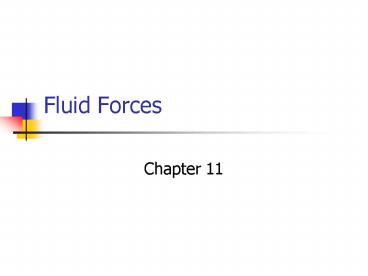Fluid Forces PowerPoint PPT Presentation
1 / 26
Title: Fluid Forces
1
Fluid Forces
- Chapter 11
2
Fluid Drag Force
- Fluid Resistance Type of force that is known
technically as DRAG FORCE. - Two Types of DRAG FORCE
- SKIN FRICTION
- PROFILE DRAG
3
SKIN FRICTION-Surface Drag
- The drag caused by the fluid tending to rub along
the surface of the body. - The thin layer of fluid in contact with the solid
surface of the body does not slide.
4
Skin Friction-continued
- Boundary Layer The region of relative motion
between adjacent layers of fluid particles. This
causes layers of air to rub near the surface of
the body (friction). This friction varies from
fluid to fluid. The more viscous (resistance to
deformation) a fluid, the greater the layer
rubbing.
5
Skin Friction-continued
- Skin Friction will increase when
- The velocity of air flow increases.
- The amount of surface area oriented parallel to
the flow increases. - The roughness of the surface increases.
6
PROFILE DRAG-pressure drag
- The most common drag force in sport.
- Created when the pressure difference on one side
of the moving body is greater than that on the
other side.
7
PROFILE DRAG-continued
- The velocity of the air flow past the object is
too fast for the air to follow the contour of the
trailing side of the object as it moves through
space. This creates a BACK FLOW at the surface
of the object. This causes the flow to separate
from the surface contour. This separation in the
boundary layer causes a large turbulent low
pressure zone to be formed behind the object.
8
PROFILE DRAG-continued
- The cause of the turbulent motion behind a moving
body is the force applied by the object to the
fluid as it pushes its way through. It acts as a
resistive force to the motion of the object.
9
PROFILE DRAG-continued
- Profile drag is given its name because of the
PROFILE of the object (the area perpendicular to
the flow of the fluid). Object with less profile
smaller profile drag.
10
PROFILE DRAG-continued
- Profile drag is also called pressure drag because
the differences between the pressures on the
leading and trailing sides of the object create a
SUCTION like effect acing against the motion of
the object.
11
PROFILE DRAG-continued
- Profile drag is determined by
- The size of the low-pressure zone on the rear
side of the object. - The more abrupt the change of shape near the rear
of the object. - The orientation of a body relative to the fluid
flow.
12
PROFILE DRAG-continued
- FORM DRAG is another name given to PROFILE OR
PRESSURE DRAG because the form or shape of the
object will determine how smoothly the object can
cut through the fluid. Objects that are more
streamlined in shape are those that tend to
create a streamlined flow pattern so that
turbulent flow is minimized.
13
Relative Influence of Factors Causing Drag
- Flow Velocity plays a major role in drag forces
on objects. - If velocity is doubled, drag is quadrupled
14
The Effects of Drag on Different Masses
- Increasing or decreasing the mass of a body has
no effect on the magnitude of the drag force
acting against it. - The mass of the body DOES determine in part, how
motion will be affected by that drag force. - Golf Ball/Ping Pong Ball Example
- Basketball/Balloon Example
15
Fluid Drag as a Propulsive Force
- Drag Forces act in the same direction that the
body is moving. - Sailboat
16
Fluid Lift Forces
- AERODYNAMIC LIFT FORCE Always directed
perpendicular to the oncoming flow and to drag
force and is not always directed UPWARD.
17
Lift Forces-continued
- They influence the trajectory of projectiles with
certain shapes. - Discus
- Javelin
- Frisbee
- Ski jumpers
- Sky divers
18
Lift Force Acting on Shapes and Surfaces
- The object to be lifted must have a airfoil, or
wind like shape. - As air flows past the airfoil, it flows faster
over the upper curved surface and slower
underneath.
19
Lift Force Acting on Shapes and Surfaces-continued
- The flow-velocity difference existing between
opposite sides of an object causes a pressure
difference between the two sides.
20
Lift Force Acting on Shapes and Surfaces-continued
- BERNOULLIs PRINCIPLE Where the flow velocity
is fast, the pressure is low where the flow
velocity is slow, the pressure is high.
21
Lift Force Acting on Shapes and Surfaces-continued
- The existing pressure difference causes the
airfoil to experience a force directed from the
region of HIGH pressure to LOW pressure. - The direction of this lift force is PERPENDICULAR
to the flow direction past the object. (Drag
force is directed parallel to the flow direction)
22
Lift Force Acting on Shapes and Surfaces-Continued
- Angle of Attack (If an object is not airfoil
shaped, the difference in flow velocity and
pressure may be achieved by tilting the object
relative to the direction of flow past it.) THE
ANGLE FORMED BTW THE MAIN PLANE OF THE OBJECT AND
THE FLOW DIRECTION.
23
Lift Force Acting on Shapes and Surfaces-Continued
- As the ANGLE of ATTACK increases, the difference
in flow velocity and pressure on opposite sides
also increases, and LIFT FORCE IS GENERATED. - Lift force will decrease and drag force will
increase past a Critical Max Angle. - Objects stall as a result of increasing drag
force and the loss of lift force at a specific
angle.
24
Lift Force Acting on Shapes and Surfaces-Continued
- The best angle of attack depends on the shape of
the object and the relative speed and direction
of fluid flow.
25
Hydrodynamics
- Skin Friction
- Profile Drag
- Wave Drag
- Propulsive Drag/Lift Force
26
Magnus Effect
- A lift force caused by a spin on an object is
called a MAGNUS FORCE. - Ball Example

